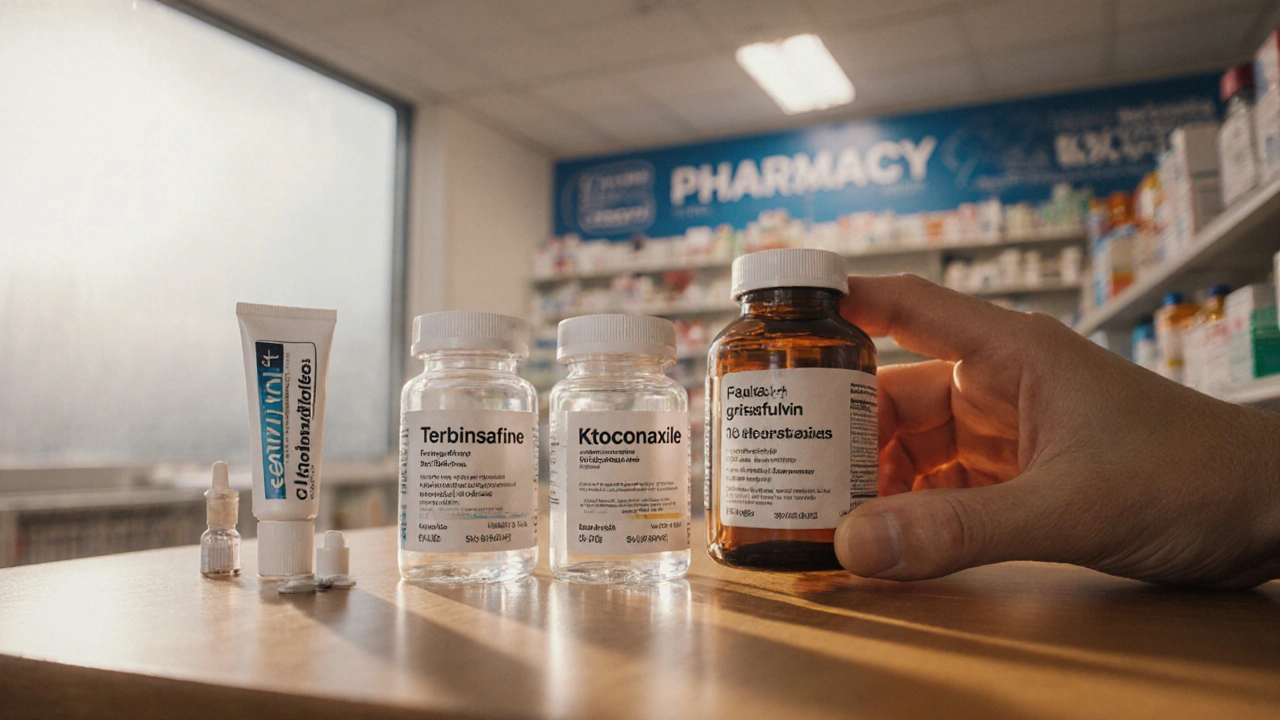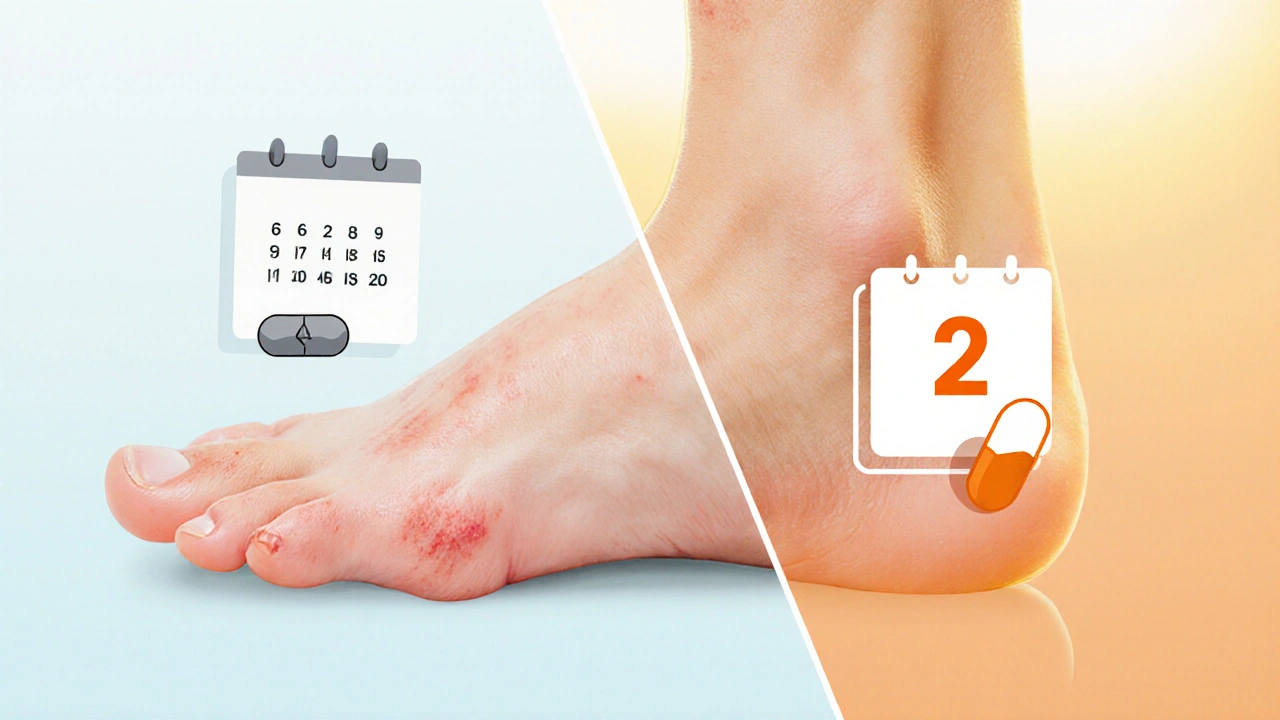Fulvicin (Griseofulvin) vs. Top Alternatives: Benefits, Risks & Costs
 Sep, 30 2025
Sep, 30 2025
Antifungal Treatment Comparison Tool
Select Your Condition
Choose Treatment Preference
When a stubborn fungal infection refuses to clear up, doctors often reach for a prescription that’s been around for decades: Fulvicin is a griseofulvin‑based oral antifungal marketed primarily for ringworm, athlete’s foot, and related skin infections. While it still gets the nod in many clinics, newer agents promise faster relief, fewer side effects, and shorter treatment courses. This guide walks you through the science, the stats, and the real‑world pros and cons so you can decide whether Fulvicin remains your best bet or if a newer alternative fits your lifestyle better.
TL;DR - Quick Takeaways
- Fulvicin (griseofulvin) works by disrupting fungal cell division; treatment often lasts 4‑8 weeks.
- Terbinafine delivers a cure in 2‑4 weeks for most dermatophytes and has the lowest side‑effect profile.
- Itraconazole and fluconazole are oral azoles that cover a broader range of fungi but require liver monitoring.
- Ketoconazole and clotrimazole are topicals useful for mild cases; they avoid systemic exposure.
- Cost varies widely: generic griseofulvin is cheapest, while brand‑name terbinafine can be 3‑5× more expensive.
What Is Fulvicin (Griseofulvin)?
Fulvicin contains the active ingredient griseofulvin, a fungistatic compound originally isolated from the fungus Penicillium griseofulvum in the 1930s. After oral ingestion, the drug is absorbed and transported to the skin, hair, and nails where it accumulates in keratinized tissue. Its hallmark is a slow but steady inhibition of fungal mitosis, meaning the pathogen can’t reproduce effectively while the immune system clears the infection.
How Griseofulvin Works (Mechanism of Action)
Griseofulvin binds to fungal microtubules, the scaffolding that pulls chromosomes apart during cell division. By destabilizing these structures, the drug prevents spores from turning into active hyphae. The result is a static infection that slowly shrinks over weeks. Because the action is indirect, the drug is less likely to cause rapid resistance, but it also means healing is slower compared with modern fungicidal agents.
Typical Uses, Dosage, and Treatment Length
- Indications: tinea corporis (ringworm), tinea pedis (athlete’s foot), tinea capitis (scalp ringworm), and onychomycosis (nail fungus) when other options are unavailable.
- Usual adult dose: 500mg to 1g daily, divided into two doses.
- Duration: 4weeks for skin infections, up to 12weeks for nail involvement.
- Special considerations: Take with a fatty meal to improve absorption; avoid grapefruit juice which can interfere with metabolism.
Pros and Cons of Fulvicin
Pros:
- Well‑studied, over 80years of safety data.
- Cheap generic form - often under $10 for a month’s supply.
- Low risk of severe drug-drug interactions compared with azoles.
Cons:
- Long treatment courses can lead to poor adherence.
- Common side effects: headache, nausea, photosensitivity, and occasional liver enzyme elevation.
- Not effective against yeasts like Candida or Candida‑related skin infections.

Modern Alternatives - An Overview
Newer oral and topical agents hit the fungal target harder and faster. Below is a snapshot of the most frequently prescribed alternatives.
- Terbinafine - a fungicidal allylamine that concentrates in keratin and clears dermatophyte infections in as little as 2weeks.
- Itraconazole - a broad‑spectrum azole effective against dermatophytes, molds, and many yeasts; requires liver function monitoring.
- Fluconazole - an azole with excellent oral bioavailability; works well for Candida‑related skin infections and some dermatophytes.
- Ketoconazole - available as a cream or shampoo; useful for mild tinea versicolor and seborrheic dermatitis.
- Clotrimazole - a topical imidazole applied twice daily; great for athlete’s foot and jock itch.
Deep Dive into Each Alternative
Terbinafine
Terbinafine is a fungicidal allylamine that blocks fungal squalene epoxidase, causing toxic buildup of squalene within the cell. This leads to rapid cell death, which translates into shorter courses-typically 250mg daily for 2‑4weeks. Success rates hover around 90% for tinea corporis and up to 85% for onychomycosis, making it a go‑to for patients who can’t tolerate long‑term therapy. Side effects are usually mild (taste disturbance, GI upset) but rare cases of hepatotoxicity demand baseline liver tests.
Itraconazole
Itraconazole inhibits fungal cytochrome P450 enzymes, halting ergosterol synthesis. It’s taken as 200mg twice daily for 2‑6weeks, depending on infection depth. Because itraconazole is metabolized heavily by the liver, clinicians monitor ALT/AST every 2weeks during treatment. It covers a wider spectrum-including molds like Aspergillus-so it’s often chosen for complicated or mixed infections. Pulse dosing (200mg twice daily for 1week per month) can reduce hepatic load for chronic nail infections.
Fluconazole
Fluconazole also targets ergosterol synthesis but has a longer half‑life (≈30hours), allowing once‑daily dosing. Doses range from 150mg to 400mg depending on severity. It shines in Candida‑driven skin and mucosal infections and penetrates nail beds reasonably well. The major drawback is growing resistance in some dermatophytes, so susceptibility testing is advised for persistent cases.
Ketoconazole (Topical)
Topical ketoconazole 2% shampoo or cream is a fixture in dermatology cabinets. It disrupts the fungal cell membrane, offering a quick, low‑systemic‑risk option for tinea versicolor, dandruff, and mild seborrheic dermatitis. Application 2‑3 times per week for 4‑6weeks yields visible improvement in most patients. Because it stays on the skin, systemic side effects are negligible.
Clotrimazole (Topical)
Clotrimazole works similarly to ketoconazole but is sold as a 1% cream or spray for athlete’s foot, jock itch, and diaper rash. The typical regimen is twice‑daily application for 2‑4weeks. It’s inexpensive (often under $5) and safe for children over 2years, making it a household staple.
Comparison Table: Fulvicin vs. Top Alternatives
| Medication | Drug Class | Typical Indications | Route & Duration | Success Rate (%) | Common Side Effects | Average Monthly Cost (US$) |
|---|---|---|---|---|---|---|
| Fulvicin (Griseofulvin) | Fungistatic (griseofulvin) | Dermatophyte skin & nail infections | Oral; 4‑12 weeks | 70‑80 | Headache, nausea, photosensitivity | 8‑12 |
| Terbinafine | Allylamine (fungicidal) | Dermatophyte skin, nail, and hair infections | Oral; 2‑4 weeks (skin), 6‑12 weeks (nail) | 85‑95 | GI upset, taste disturbance, rare hepatotoxicity | 30‑45 |
| Itraconazole | Azole (fungistatic) | Broad‑spectrum: dermatophytes, molds, yeasts | Oral; 2‑6 weeks (continuous) or pulse | 80‑90 | Liver enzyme elevation, drug interactions | 35‑55 |
| Fluconazole | Azole (fungistatic) | Candida skin infections, some dermatophytes | Oral; 1‑4 weeks | 75‑85 | Headache, abdominal pain, rare liver toxicity | 20‑30 |
| Ketoconazole (topical) | Imidazole (fungistatic) | Tinea versicolor, seborrheic dermatitis | Topical; 4‑6 weeks | 70‑80 | Local irritation, itching | 5‑10 |
| Clotrimazole (topical) | Imidazole (fungistatic) | Athlete’s foot, jock itch, diaper rash | Topical; 2‑4 weeks | 80‑90 | Mild burning, rash | 3‑8 |
How to Choose the Right Antifungal for You
Pick a treatment based on three practical criteria: infection type, speed of relief needed, and tolerance for side effects or monitoring.
- Skin‑only infections (ringworm, athlete’s foot): If you want the quickest cure and can afford a slightly pricier pill, terbinafine is the winner. For budget‑conscious patients, Fulvicin still works, but expect a longer regimen.
- Nail infections: Terbinafine and itraconazole pulse dosing both achieve higher cure rates than griseofulvin. Topical options rarely penetrate the nail plate effectively.
- Patients with liver issues or many meds: Griseofulvin’s low interaction profile makes it safer than azoles, which compete for the same liver enzymes. Topical agents bypass liver metabolism entirely.
- Pregnant or breastfeeding: Many azoles are contraindicated. Griseofulvin is category C, and its safety data is limited; consult a specialist.
In every case, finish the full course-even if symptoms fade-because stopping early invites recurrence or resistance.
Potential Drug Interactions & Contraindications
Griseofulvin is metabolized by CYP2C9 and CYP3A4, but its interaction footprint is modest. Avoid co‑administration with warfarin (increased INR) and oral contraceptives (reduced efficacy). Itraconazole and fluconazole, on the other hand, are strong CYP3A4 inhibitors and can raise levels of statins, certain antiarrhythmics, and benzodiazepines. Always inform your pharmacist of every prescription, supplement, and herbal product you take.
Final Thoughts - Is Fulvicin Still Worth It?
If you value a cheap, well‑documented medication and don’t mind a longer treatment, Fulvicin remains a solid option. However, for most patients seeking rapid relief, lower side‑effect risk, and higher cure percentages, newer agents like terbinafine or pulse‑dosed itraconazole often provide a better overall experience. The key is to match the drug’s strengths to your infection’s demands, your health history, and your budget.

Frequently Asked Questions
Can I use Fulvicin for athlete’s foot?
Yes, Fulvicin is approved for tinea pedis (athlete’s foot). Expect to take it for 4‑6weeks, and watch for side effects like nausea or photosensitivity.
How does terbinafine compare in cost to Fulvicin?
Generic griseofulvin typically costs under $12 per month, while brand‑name terbinafine runs $30‑$45 monthly. Insurance may narrow the gap, but out‑of‑pocket expenses are usually higher for terbinafine.
Do I need liver tests while taking Fulvicin?
Routine liver monitoring isn’t required for short courses of griseofulvin, but a baseline test is wise if you have pre‑existing liver disease.
Is it safe to use topical ketoconazole with oral griseofulvin?
Yes, combining a topical agent with oral therapy is common and usually safe, since the topical drug stays on the skin and doesn’t add systemic load.
What should I do if I miss a dose of Fulvicin?
Take the missed dose as soon as you remember, unless it’s almost time for your next dose. In that case, skip the missed pill and continue with your regular schedule-don’t double‑dose.
Krysta Howard
September 30, 2025 AT 21:18Alright, let’s cut through the fluff: Fulvicin is cheap and has a decent safety record, but expect a marathon‑style treatment that can leave you feeling like you’ve been stuck on a treadmill for weeks 😤. If you’re budget‑tight and can tolerate a slow‑burn approach, it still has its place, especially when drug interactions are a concern.
Elizabeth Post
September 30, 2025 AT 21:28Hey everyone! Think of Fulvicin as the steady runner in a relay race – not the fastest, but reliable. Pair it with good hygiene and you’ll likely see success, just be patient with the timeline.
Brandon Phipps
September 30, 2025 AT 21:40So, diving deep into the practicalities of antifungal therapy, we have to consider several intertwined factors that influence both efficacy and patient adherence. First, the pharmacokinetic profile of griseofulvin dictates a prolonged half‑life, which translates into the longer treatment courses you see in the table. Second, the drug’s mechanism-binding to fungal microtubules-means it’s fungistatic rather than fungicidal, so your immune system does the heavy lifting. Third, compliance suffers when patients must take a pill daily for up to three months; many simply stop when symptoms wane, leading to relapse. Fourth, the cost advantage of Fulvicin is undeniable, especially for uninsured patients, but price alone doesn’t guarantee a cure. Fifth, the side‑effect spectrum is relatively mild, yet photosensitivity can be a real nuisance for outdoor workers. Sixth, drug‑drug interactions are modest compared with azoles, a boon for polypharmacy patients. Seventh, liver monitoring isn’t as stringent, but baseline checks are still wise. Eighth, in cases of nail onychomycosis, the nail plate barrier reduces drug penetration, making newer agents like terbinafine more attractive. Ninth, for scalp ringworm, oral therapy is essential because topical agents seldom reach the hair follicle depths required. Tenth, the emergence of resistant dermatophyte strains remains low for griseofulvin, but vigilance is needed. Eleventh, patient education on taking the drug with fatty meals boosts absorption significantly. Twelfth, the psychosocial impact of long‑term therapy should not be ignored; patients often feel discouraged. Thirteenth, healthcare providers should weigh the trade‑off between speed (terbinafine) and safety (griseofulvin). Fourteenth, insurance formularies sometimes force a switch, so clinicians must stay flexible. Fifteenth, overall, Fulvicin remains a solid, cost‑effective option when the clinical scenario aligns with its strengths.
yogesh Bhati
September 30, 2025 AT 21:53Yo, if we look at the bigger picture, the whole concept of "cheaper is better" sometimes hides the hidden costs of a longer battle – like a marathon you didn't train for. Also, think about how the sun's rays can mess with Fulvicin; it's like the drug says "I need shade" while you're out jogging.
Akinde Tope Henry
September 30, 2025 AT 22:03Fulvicin may be cheap but it is not for the weak‑hearted; the time you waste is the price you pay.
Brian Latham
September 30, 2025 AT 22:16Honestly, I think the whole comparison table is just a marketing gimmick; pick whatever your doctor wrote on the prescription.
Barbara Todd
September 30, 2025 AT 22:30Trying to be helpful, but if you’re already on a cheap drug, why bother reading this? Just finish the course.
nica torres
September 30, 2025 AT 22:43Let's keep the momentum up! If you decide to try Fulvicin, set a reminder on your phone so you don't miss a dose. Small consistency wins big results! 🌟
Dean Marrinan
September 30, 2025 AT 22:56Oh great, another budget option that makes you wait for weeks-because who doesn't love buffering their life with a slow‑acting fungus fighter? 🙃 But hey, if you love the suspense, go ahead and pick it.
Oluseyi Anani
September 30, 2025 AT 23:10From an ethical standpoint, prescribing a drug with lower efficacy just to save a few bucks can be questionable; patients deserve the best chance at cure, not a bargain price.
Jeremy Wolfe
September 30, 2025 AT 23:23Team, remember that the best choice depends on the individual’s health profile-if liver concerns are a thing, Fulvicin's lighter interaction load can actually be a win.
Rahul yadav
September 30, 2025 AT 23:36👀 Picture this: a patient stuck in a 12‑week drama, waiting for their nails to clear while the rest of the world moves on. It feels like a slow‑motion movie, but sometimes the plot twist is worth the patience.
Dan McHugh
September 30, 2025 AT 23:50Sounds good.
Sam Moss
October 1, 2025 AT 00:03Got it, just remember to take it with a fatty snack-helps the drug get absorbed better.
Suzy Stewart
October 1, 2025 AT 00:16Quick tip: keep an eye on any skin rash and call your doctor if it gets worse-early detection prevents bigger problems 🚀.
Traven West
October 1, 2025 AT 00:30Remember: grammar matters even in medical notes. Mistakes can lead to mis‑dosing.
Jonny Arruda
October 1, 2025 AT 00:43And don’t forget to double‑check the prescription label; a swapped pill can ruin the whole plan.
John and Maria Cristina Varano
October 1, 2025 AT 00:56If you’re from a country where they don’t even have the newer drugs, then Fulvicin is your only lifeline, so stop whining about cost.
Melissa Trebouhansingh
October 1, 2025 AT 01:10While one might be tempted to dismiss the comparative analysis as merely a superficial list, a deeper contemplation reveals that the nuances of pharmacodynamics, patient adherence, and socioeconomic constraints coalesce into a complex tapestry that demands a meticulous, scholarly evaluation of each therapeutic option, beyond the rudimentary cost considerations that so often dominate superficial discourse.